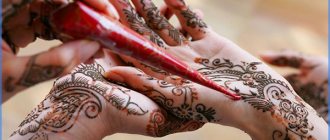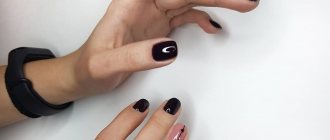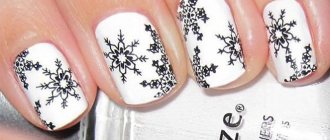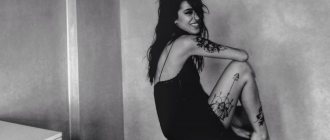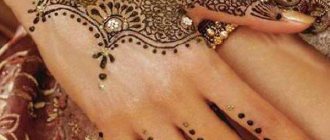“Evolution” of a young painter
Drawing for a child is not art, but speech.
Drawing makes it possible to express what, due to age restrictions, he cannot express in words. In the process of drawing, the rational goes into the background, prohibitions and restrictions recede. At this moment the child is absolutely free. A child's drawing most often clearly demonstrates the area of interest of the youngest artist. In the early stages of development (up to three years) these are dashes, lines, circles. The child “tests” a pencil or brush and experiments. Usually he first makes a drawing, and then comes up with what he depicted, what it is
it might be similar.
Later (by the age of four) the idea
.
From a certain age (3.5 – 4 years), a person becomes the object of close attention and study. From the point of view of psychodiagnostics, a person’s drawing is one of the most accurate and reliable sources of information.
The only difficulty is that the information contained in such a message is figuratively “encoded”, and the drawing must be “read” correctly.
Psychologists who use drawing techniques in their work must have sufficient qualifications and experience working with children. However, attentive parents can always notice something unusual in a child’s creative work, sense his mood, and sense hidden tension. Therefore, as “first aid”, we offer several lessons on analyzing a child’s drawing.
The details of a child's drawing depend on age
The child should be asked to draw his family. Moreover, so that everyone is busy with some kind of activity. Let him have a selection of colored pencils and enough paper - a regular landscape sheet (A4 format) will do just fine. Do not rush your child or comment on his drawing during the drawing process. And when he finishes the family portrait, it’s time to ask questions: who exactly did he paint and what are all these characters doing?
When starting to analyze a drawing, adults should take into account that its content and, relatively speaking, quality depend on the age of the young artist.
In three-year-old children, people most often look like “cephalopods”: certain creatures whose body and head are a single “bubble” with legs. A face may also appear. But, strictly speaking, it would be more correct to analyze a drawing from the point of view of personal development and psycho-emotional state from the age of 4–5
.
By the age of four, a child usually already depicts a person in the form of two ovals with arms and legs - sticks.
In the drawings of five-year-old children, the head, eyes, torso, arms, and legs appear.
At six years of age, the nose, mouth, and fingers are added to the above (their number is not significant).
By the age of seven, “painters” no longer lose sight of such details of the human image as the neck, hair (or hat), clothing (at least in schematic form), and depict arms and legs with double lines. Typically, these criteria are used when assessing a child’s mental development.
Analysis of a child's drawing based on... one's own feelings
To correctly read a child’s drawing, you need to trust your impressions.
. What emotions does it evoke? Peace and tranquility or worry and anxiety?
To more accurately determine this, you can try to describe the drawing using the concepts: “light” - “dark”, “bright” - “dim”, “harmonious” - “inharmonious”, “calm” - “restless”, “ordered” - “ disorderly”, “cheerful” - “sad”, “aggressive” - “benevolent”, “rich” - “poor”, “heavy” - “light”. This will help to more accurately perceive the child’s condition.
This method of assessment may seem difficult. In this case, you can find equally interested parents and exchange the kids’ creations with them. And then share with each other your feelings about the drawings as “independent experts.”
All words that can be used to describe the drawing are related to the current state of the child. For example, some negative definitions.
- Inharmonious - - restless in color, load of parts of the picture, character dynamics.
- Disorderly – chaotic in arrangement on the sheet.
- Sad - in which family members are separated, are in different parts of the sheet, their faces are joyless or completely absent.
- Aggressive – with threatening facial expressions, postures, possibly with weapons.
With a large number of negative assessments, we can talk about the child’s internal psychological distress.
However, you should not make hasty conclusions based on one single drawing. Perhaps the child is offended by someone or does not feel well enough. A child’s emotional experiences are usually vivid and short-lived, but they have a significant impact on all of his immediate activities, including creative ones.
Home hierarchy
Particular attention is paid to the analysis of the structure of the family picture. It is necessary to compare its real composition with that depicted by the child on paper. You should also evaluate the order of drawing, the size of the figures and their location on the sheet.
- The first and largest, as a rule, is depicted the most significant family member in the understanding of the young artist.
- Children usually draw themselves next to those to whom they feel the greatest affection.
- And farthest away in the picture is the child’s most unsympathetic relative.
- The image in profile or from the back also indicates a tense relationship between this family member and the author of the drawing.
Children live by momentary experiences. And often an emotional relationship with someone close (a recent quarrel, resentment) can make adjustments to the drawing. In this case, the baby may even “forget” someone.
For example, 6-year-old Alyosha does not draw his father, who pays little attention to him and is rude. And his absence in the picture is explained by the fact that “dad went on a business trip.”
Alisa (4 years old) did not draw her little sister Ksyusha, explaining her absence by saying that the baby was “sleeping in another room.” The girl cannot come to terms with the fact that her mother does not pay as much attention to her as before because of her sister.
The opposite situations also occur, when the child depicts in the drawing really non-existent family members. Sasha (5 years old) surprised his mother a lot when he drew a picture of a baby playing next to him and announced that he finally had a brother!
Such “adjustments” to the composition of the family are made by children who are dissatisfied with their emotional situation. They need more friendly attention from adults and games “on equal terms”, or better yet, entertainment in the company of other similar kids.
What family members are doing also plays an important role when analyzing a child’s drawing.
If they are united by some common cause, most often this indicates a favorable family climate.
A very significant indicator
.
By drawing himself separately from others, a child can “signal” his isolation in the family. If he separates his family from each other with partitions or places them in different “rooms,” this may indicate problems in communication.
The size of the image indicates the place this person occupies in the emotional life of the family. For example, if a child draws a younger brother or sister larger than himself, then we can assume exceptional attention to him from his loved ones. He "occupies a lot of space in their lives."
The absence of the smallest artist in the drawing is a frequent sign that the child feels lonely in the family and has “no place” in relationships between loved ones. You can check this by asking your child the question: “Perhaps you forgot to draw someone?” It happens that a child ignores even a direct instruction: “you forgot to draw yourself” or explains: “there is no space left,” “I’ll finish drawing it later.” This situation is a serious reason to think about family relationships.
A very dense image of figures, as if overlapping each other, speaks of equally close relationships between people close to the baby or his need for such connections.
“Writing manner” assessment
A fairly common sign of increased anxiety in a child is self-correction.
Especially those that do not lead to improved image quality. There are drawings made from individual small strokes - the child seems to be afraid to draw a decisive line. Sometimes the entire drawing or some of its parts is hatched. In such cases, one can also assume increased anxiety in the young artist.
It is worth paying attention to the exaggeratedly large eyes in the portrait, especially if their pupils are densely shaded. Perhaps the baby is experiencing a feeling of fear.
Numerous decorations,
the presence of additional details and elements of the costume from the author of the drawing indicate the child’s demonstrativeness, his desire to be noticed, and his craving for external effects. This is more common in girls.
Very weak pencil pressure, low (not for age) detail
pattern is found in children who are asthenic, prone to fatigue, emotionally sensitive, and psychologically unstable.
And children, who easily change their mood without any apparent reason, usually often change the pressure during the drawing process: some lines are barely noticeable, others are drawn with noticeable effort.
Impulsive kids often do not complete the lines or, on the contrary, draw in a sweeping manner, so their drawings give the impression of being careless and uncontrolled. Here, strong pressure and gross violations of symmetry attract attention.
Sometimes the drawing “does not fit” on the sheet. There are drawings where all the figures are depicted very small.
Usually the entire composition is oriented towards some edge of the sheet. This means that the baby feels weak and does not believe in his own strength. Perhaps one of his relatives is very strict with him or the requirements for the child do not correspond to his real capabilities.
If the baby portrays himself in an open position
(arms and legs are widely spaced, the figure is large, often round), this indicates his sociability and cheerfulness. On the contrary, a “closed” pose (arms pressed to the body or hidden behind the back, elongated, angular figure) rather indicates a closed person who tends to restrain his feelings and thoughts.
Both in the drawings of boys and in the drawings of girls one can often notice symbols of aggressive tendencies
behavior: large accented fists, weapons, intimidating pose, clearly drawn nails and teeth.
Despite the apparent hostility, they can be an expression of a defensive form of behavior .
Adults should figure out what is a source of increased emotional danger for their child, and why he needed such a demonstration of his strength. A special place is occupied by drawings that violate accepted image standards
. In particular, the image of the genitals. For young children (under 4 years old) this is rather a common occurrence. This reflects the tendency towards naturalness of life in all its manifestations. For older preschoolers, such a drawing speaks of demonstrativeness, a desire to attract attention in a provocative way, and serves as an expression of aggression.
Is the palette a mirror of the soul?
Children very early begin to “feel” color and select it according to their mood and attitude. Dr. Max Lüscher, a psychologist and color researcher, studied different people's color choices. He came to the conclusion that the choice of color reflects the psychological qualities of a person and his state of health.
Number of colors the child uses
can be viewed from several perspectives. First of all, this is a characteristic of the level of development of the emotional sphere as a whole.
Typically children use 5-6 colors. In this case, we can talk about a normal average level of emotional development.
A wider palette of colors suggests a sensitive nature, rich in emotions.
If a child over 3-4 years old draws with 1-2 colored pencils, this most likely indicates his negative state at the moment: anxiety (blue), aggression (red), depression (black).
Using only a simple pencil (if there is a choice) is sometimes interpreted as a “lack” of color, thus the child “reports” that there is a lack of bright colors and positive emotions in his life.
The most emotionally significant figures are highlighted with a large number of colors.
And openly rejected characters are usually drawn in black or dark brown.
Colors can also convey certain character traits and states. Each color has its own symbolic meaning
:
- dark blue
– concentration, focus on internal problems, the need for peace and satisfaction, introspection; - green –
balance, independence, perseverance, stubbornness, desire for security; - red –
willpower, eccentricity, outward focus, aggression, increased activity, excitability; - yellow –
positive emotions, spontaneity, curiosity, optimism; - purple – fantasy
- brown –
sensual support of sensations, slowness, physical discomfort, often negative emotions; - black –
depression, protest, destruction, urgent need for change; - gray
– “absence” of color, indifference, detachment, desire to leave, not to notice what is disturbing.
From theory to practice
So, the kid spent a few minutes over a sheet of paper with pencils in his hands, and the picture is ready. How much that is important for him and for his parents is hidden in this drawing! Let's try to read it?
Here the child has depicted himself, but the pose is unstable and there is no face. How to communicate without a face? - Difficult! Here is the baby in the crib, lying down to rest. Perhaps he was tired. Or maybe he's sick? And the color I chose was brown. Yes, that’s right – temperature!
Why do all the girls draw princesses? This is exactly how they feel or...really want it. Just to be in the center of attention, to be the most... And what is the demand for a princess?
Here is a boy, armed to the teeth. He needs protection. Maybe someone offended him.
Psychology of creativity: what children's drawings say
Interpretation of a drawing by color
Take a look at your child’s creation and try to guess what the child’s drawing says based on the main color. Psychology interprets colors as follows.
- The predominance of pastel shades (blue, pink, purple) in the design speaks of harmony and personal freedom. For “pink” babies, tactile sensations are important, hug them and kiss them more often.
- The predominance of red indicates the child’s openness and activity. As a rule, such a baby is excitable, restless and often disobedient. However, there is nothing to worry about, because this is just his individual feature. Such children are full of energy. As they grow up, they will be able to achieve success in life.
- If a child's drawing is made in blue, in psychology this is a sign of balance. Such children are calmer and more leisurely.
- Green is the color of stubbornness and perseverance. Light green indicates the need for protection. Dark green should alert parents – the child lacks attention and love. Such children grow up withdrawn, so from a very young age they need to be nurtured to be open and instill confidence in security.
- According to the psychology of children's drawings, yellow is the color of a dreamy child with a lively imagination and a well-developed imagination. These kids love to play alone, using abstract toys (various twigs, pebbles, etc.).
- If a child draws an orange sky, an orange mother, this is a sign of excitement that has no outlet. It is difficult to calm such babies, so it is better to direct their energy to helping their parents around the house. It’s very good if among these things there is one that will arouse the child’s interest.
- The predominance of violet is an indicator of high sensitivity. This is a creative person with a rich inner world. These are vulnerable children who need affection and encouragement more than others.
The predominance of dark shades in a child’s drawing should definitely cause concern. Psychology says the following about this.
- Brown: negative emotions, health problems, experiencing family troubles.
- Grey: poverty, rejection, isolation.
- Black: Stress, threat and even psychological trauma.
- Dark red (burgundy with shades of black): depression, anxiety.
The predominance of these colors indicates problems for which it is better to immediately consult a psychologist.
Pressing the pencil
Weak pressure indicates timidity and passivity. If your baby constantly erases lines with an eraser, this is a sign of uncertainty and anxiety. Strong pressure is evidence of emotional tension. And if the pressure is so strong that the paper tears, this indicates conflict and hyperactivity.
Position and size of the picture
The image at the top of the sheet is a sign of high self-esteem or daydreaming. The location of the small picture at the bottom of the page means emotional distress, low self-esteem, depression.
If the drawing turned out to be so large that the child glued another piece of paper to it in order to complete the missing part, this is an indicator of an anxious state. Also, such drawings are often drawn by hyperactive children.
At the end of the article, we have prepared for you a checklist “Creative clutter in the apartment, how to control it!” Download it and you won’t be afraid of children’s creative experiments!
Examples of analysis of specific drawings
Child's drawing 1, the author of this “family portrait” is Alyosha (6 years old)
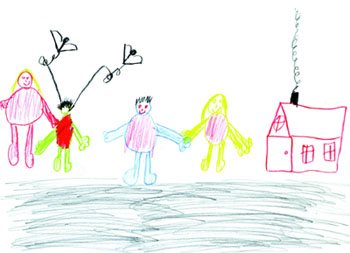
Age criterion
The child’s behavior contains features characteristic of an earlier age; the emotional-volitional sphere is characterized by immaturity. All characters in the picture are depicted in the same way. Clothing, with its inherent details, is missing. Hairstyle acts as a symbolic sign of gender. The characteristic absence of a neck in the depicted people in this case indicates the difficulty of controlling the mind over bodily impulses, that is, Alyosha’s behavior is characterized by high mobility, and at times, disinhibition and impulsiveness.
Emotional characteristics
The drawing is bright, light, cheerful, orderly, rather friendly.
Features of the family image
The family in the picture is shown in its entirety. In the center of the composition is dad as an important subject in the domestic hierarchy. We can assume with reasonable confidence that mom is physically and emotionally closer to Alyosha. The pairs formed are noteworthy: mother - son (the youngest in the family), father - daughter. Sister Lena is the furthest from the author of the drawing. Probably, not everything is going well in their relationship. It is significant that of all the family members, only dad “stands firmly on the ground.” The rest are floating, a little “in the clouds.” In general, we can talk about fairly warm and close relationships between family members. This is evidenced by the small distance between them, the choice of a common color and the image in the same color scheme of a house with smoke from a chimney, symbolizing the “warmth of the family hearth.”
"Manner of writing"
All lines of the drawing are made with confident, decisive movements. It is probably this style of behavior that is most characteristic of Alyosha. But strong pressure and accentuated shading of the boy’s body speak of internal restlessness, anxiety, perhaps physical (literally bodily
) malaise. The hairstyle reveals an active, sometimes perhaps aggressive, nature. An interesting detail is the peculiar antennas (according to Alyosha), which in the picture “grow” from the boy’s ears. They symbolize the need for information to compensate for difficulties in communication (the child in the image does not have a face). The poses of all the characters are open, their figures are round, which suggests cheerful, sociable people. In the case of Alyosha, this apparent contradiction may mean: “I want to communicate, play, but they don’t always understand me.”
Palette
The color scheme of the picture is very symbolic. The little artist chose the signal red color for all family members, especially for himself. This indicates an outward orientation, sociability, and increased activity of the author of the drawing. Additional green emphasizes the desire for independence and the desire to insist on one's own as a habitual way of behavior. An important detail of the drawing is the clearly drawn surface of the earth. If Alyosha spent a lot of time on her image, this is probably something important to him. In this case, we can consider the earth as a need for support, greater stability and stability. The goal of analyzing a drawing is always to gain a deeper understanding of the child, look at the family through his or her eyes, and identify paths to positive change. In this case, I would like to recommend to Alyosha’s parents that they pay more attention to deep, confidential communication with their son, talk to him more often just like that, and ask his opinion on various issues. They should also consider what is the difficulty of contact between son and daughter. And active recreation and outdoor games can significantly reduce emotional and physical stress.
Children's drawing 2. Its author is Maxim (4 years 10 months)
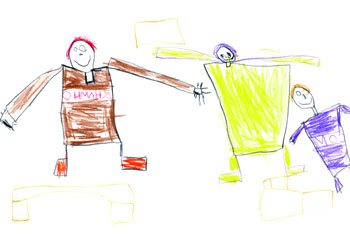
Age criterion
This pattern is more typical for six-year-old children. We can say that the boy is developing intellectually ahead of his age.
Emotional characteristics
The drawing is bright, dynamic, but restless.
Features of the family image
The family is depicted in its entirety. Noteworthy is the sexual identification of the young author with his father (see clothes). However, emotionally the child is still closer to his mother, which is typical for a preschooler. It’s interesting that the boy doesn’t seem to have enough space in the drawing; he’s unsteady on his feet. His position is unstable and changeable.
Palette
The child chose the color purple for himself, which, combined with his insecure position in the family (this was mentioned above), indicates possible psycho-emotional instability and frequent mood swings. For mom, the little artist chose an energetic, somewhat chaotic, yellow color. Dad is brown. In his image, attention is concentrated on the physical body. This is how a child sees his parents.
"Manner of writing"
The figures are large, angular - most likely, in the child’s communication there is some straightforwardness and a tendency to conflict (sharp corners). Noticeable shading and clearly drawn pupils suggest the presence of hidden anxiety.
Children's drawing 3, Petya, 6 years old
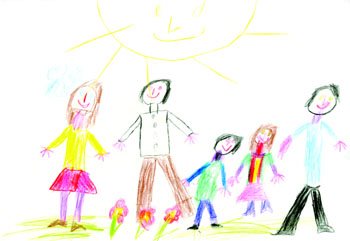
The drawing is bright, rich, energetic, well organized. It is quite consistent with the artist's age.
The family structure is divided into “adult” and “children” groups. The younger brother and sister strive to be emotionally and physically closer to Petya. Probably the family has psychologically close, equal relationships.
Mom is the most vivid, emotional image. The child identifies the image of the mother with the help of color and draws it first.
Petya portrays himself as an adult. The arms are somewhat shortened compared to other images. This is usually found in the drawings of children who consider themselves insufficiently skilled and are critical of their practical skills and capabilities.
The sun and flowers are very often found in children's drawings. It is worth paying attention if their appearance is unjustified by the situation. For example, the sun appears in a drawing of a room. Then we talk about the need for warmer relationships in the family. In Petya’s drawing, these symbols most likely indicate a positive attitude towards his family.
Children's drawing 4, Polina, 7 years old
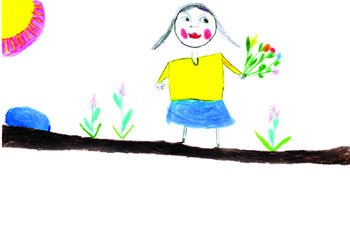
Often children draw arbitrarily, without a special task or request: “I’m drawing a girl like me.” In this case, we observe a somewhat idealized child’s idea of himself.
Let's pay attention to Polina's drawing. It is located at the top of the leaf, quite large and bright. We can talk about the child’s positive self-esteem, activity, and emotionality.
The girl is probably distinguished by high self-control, developed intelligence, and sociability. But she lacks stability (note the accentuated drawn line of the ground and the child’s small legs). From a psychological point of view, we are talking about self-doubt. This usually happens in a family where one child is being raised: he is given, as paradoxical as it may sound, too much attention, every step is controlled and directed. Thus, the child is deprived of the opportunity to somehow demonstrate independence.
Gradually getting used to this situation, the child is afraid to take the wrong step and waits for “valuable instructions.” Maybe Polina should sometimes make her own mistakes and learn from them?
Children's drawing 5, Alexandra, 4 years old
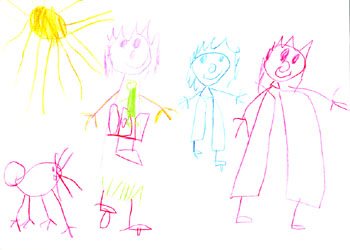
The drawing is dynamic, bright, somewhat chaotic. The emotional center of the family is undoubtedly the mother: warmth (the sun), the child, and the dog are concentrated around her. Her dress is decorated with a pattern.
Please note that Sasha portrays herself as equal to adults and only her legs do not reach the ground. The girl's character is probably combative, impulsive, and boyish.
The lines of the drawing are sweeping, with strong pressure, suggesting a low level of self-control. For such children, games with simple rules and involving several players are useful. Active sports will also teach you to better understand yourself and relate your desires to the interests of the team.
Torso
A symbol of a child’s idea of a person’s physical appearance, the focus of his vitality.
- angular or square – masculinity, energy, expressiveness;
- rounded shape - poise, calm character, some femininity;
- too large - the presence of unsatisfied needs that are acutely realized by a person; if it is drawn by a child of normal build, then it is an expression of inner strength;
- too small, weak, fragile - a feeling of humiliation, one’s own weakness; drawn by a strong child may be a sign of worries from past experiences.
- a strong, muscular body drawn by a fragile, weak child is a sign of compensation for the missing, ideal physical appearance for him.
Shoulders are a sign of physical strength or the need for power.
- too large, wide - strength and superiority or excessive preoccupation with strength and power; in adolescents, this may be a sign of sexual inadequacy;
- narrow, small - a feeling of low value, insignificance;
- too angular - a sign of caution, need for protection;
- sloping - despondency, despair, guilt, lack of vitality.
Navel
- in the drawing of a small child - a sign of egocentrism;
- in the drawing of an older child - an expression of infantility or a desire to withdraw into oneself.
Entrails
An extremely negative sign, indicating serious mental disorders.
Genitals
Their image is very unusual for a child, so if they are present, special significance should be given to this.
- in children's drawings this indicates early awareness, high emotional value invested in the genitals;
- in the drawings of older children this indicates early sexual development;
- in the drawings of teenagers, this is a sign of possible problems in the sexual sphere, experiences related to the issue of gender.
Palette of colors
At two years old, the child happily picks up a pencil. Even if he only draws meaningless sticks and squiggles for now, this chaos testifies to the impossibility of dividing the world into two parts: internal and external. The baby does not yet understand the shape, but he feels the color.
Yellow and purple are the most favorite colors among children. And if the child prefers them, the mother can be calm - in the child’s soul there is healthy optimism and a cheerful imagination. Red indicates rapid excitability.
Blue - that perhaps the child misses someone or something, that he is focused on internal problems.
Green - shows that he is looking for peace.
Brown means he is experiencing physical discomfort.
Particular concern should be given to the preference for black - the color of depression, protest against negative emotions.
Gray color is not typical for children's drawings, because it is the color of indifference. Please note that if a child draws only with a simple pencil, he lacks positive emotions.
Typically, preschool children draw with 5–6 colors, which shows their normal emotional state. If there are more colors in the child’s palette, this indicates his sensitivity and emotionality, and the choice of 1-2 colors in the drawing signals: the child is depressed, something is bothering him.
Analyzing the elements of the image
Head
The position of the head and face matters.
- If the head is turned to the right, the child is aimed at realizing his plans and plans. If he has something in mind, he tries to implement it, even though he abandons some ideas halfway through.
- If the head is turned to the left, plans and ideas mostly remain in the head, the child does not make attempts to implement his ideas due to indecision.
- If the head is positioned straight, the child is focused on himself, selfish, and has high self-esteem.
Ears
If ears are attached to the head, this means that the child is ready to listen. This can manifest itself as cognitive interest (listens to information), or maybe as an interest in the opinions of other people (listens to others in everything).
Eyes
In a drawing, eyes are a symbol of fear, especially if they are large, clearly drawn, and circled many times. Noticeable and large eyes are a symbol of strong fear. Drawn eyelashes speak of some coquetry, attention to one’s own appearance, and a desire to be liked.
Mouth
The mouth can be drawn in different ways: open, closed, just a line, or real lips.
- Clearly drawn lips speak of the sensuality of a child.
- If the emphasis is on language, the child is very talkative.
- Sometimes both lips and tongue are drawn. This indicates the expression of both qualities.
- If the mouth is open, but there is no tongue or lips, especially if there is shading, the child is very timid, can easily get scared, constantly doubts and does not trust. This is especially true for teenagers.
- Drawn teeth indicate verbal aggression. This aggression is usually of a defensive nature, that is, the child can respond if something happens.
Forehead
A large and high forehead is a sign of the predominance of rationality and erudition.
Unusual details on the head
Sometimes children draw different details on their heads, which can also be deciphered.
- Horns - aggressiveness or desire to defend, the ability to “butt” if necessary.
- Feathers – the desire to attract attention, to stand out, the desire to decorate oneself.
- Hairstyle, mane or fur - the child strives to indicate what gender he is and to emphasize this.
Limbs
The drawn creature can stand on its feet or paws. Their appearance also speaks about the child’s internal state.
- Massive, strong limbs indicate that the child stands firmly on his feet throughout life. He has something to rely on, he makes balanced decisions, thinks about his actions.
- Weak, thin legs or their absence indicate the fragility of internal positions and beliefs. The child makes decisions rather impulsively, his judgments are not deep.
Special attention should be paid to how the limbs connect to the body.
- If the connections are drawn well, the child carefully controls his reasoning, thinks logically and consistently.
- If the connections are drawn carelessly or are absent altogether, the child seems to be slightly out of touch with reality, his thoughts are chaotic.
In addition to legs or paws, the child can draw other limbs. They can serve as decoration, or they can have some kind of function.
- Wings, shell, additional limbs indicate that the child is attracted to various areas of activity, he is comprehensively developed, is interested in many things, and easily makes acquaintances. Such children are confident in themselves and easily take their place in life.
- Drawing tentacles indicate that the child almost always acts boldly.
- Various bows and decorations in the picture reveal in the child the desire to attract attention, demonstrativeness and mannerisms.
An interesting element in the image is the tail:
- If the tail is drawn on the right, the child has high self-esteem, he perceives himself and his actions positively. If on the left, the child is prone to self-criticism.
- If the tail looks up, the child is active and confident, if down, the child is depressed and dissatisfied with himself.
Limbs
Hands. Their function is to cling, join, interact with people around them, that is, the ability to act. This is a symbol of activity, communication and contact.
- lack of hands - passivity, inactivity, unsociability, timidity, intellectual immaturity; may indicate a feeling of guilt experienced for one’s aggressiveness;
- long – sociability, ambition, desire to collect and accumulate;
- short – internal weakness, indecisiveness, lack of communication, isolation, desire to keep oneself within limits;
- muscular, long - the need for physical strength;
- weak, long - a feeling of one’s weak physical condition, dependence, need for care;
- too large – the need for better relationships with others;
- wide arm span, flexible, mobile hands – sociability, active interaction with the outside world;
- rigid, rigid, mechanically outstretched arms bent at right angles – superficial and non-emotional contacts with the outside world;
- pressed to the body, in pockets, behind the back, hanging sluggishly along the body - guilt, self-doubt, internal tension, isolation;
- raised up - hostile attitude, aggressiveness;
- shaded – aggression;
- wider at the palm or at the shoulder - insufficient self-control, impulsiveness;
- crossed on the chest - suspiciousness, secrecy.
Palms
- large, large - a sign of an active, explosive character;
- poorly drawn - lack of communication;
- shaded - talk about the feeling of guilt that the child experiences in connection with his aggressive, hostile behavior;
- absent - evidence of inadequacy, lack of faith in one’s strengths, and a feeling of unfitness.
Fingers
- more than five - the child feels strong (if on the left hand, then in the sphere of family relationships, if on the right hand, then in the world outside the family: school, garden, yard, etc.);
- less than five - feels weaker than others;
- carefully drawn – the ability to control the situation;
- <long fingers, fists - a sign of aggression, belligerence, rebellion; if the fists are pressed to the body, aggression is suppressed.
Legs are a symbol of strong support, stability in life and freedom.
The right leg symbolizes support in non-family reality, the left – in the family.
- disproportionately long - a strong desire for independence;
- too short, thin, poorly drawn, shaded - weakness and uncertainty, a feeling of worthlessness, loss of spirit;
- absent – timidity, isolation;
- accented - rudeness.
Feet
The larger the area of support at the feet, the more firmly and confidently the character stands on the ground, the stronger his feeling of reliability.
- too long - need for security;
- too small, unstable - stiffness, dependence, feeling of insecurity;
- fingers facing the observer or absent – uncertainty;
- drawn in profile - a sign of stability and self-confidence.
